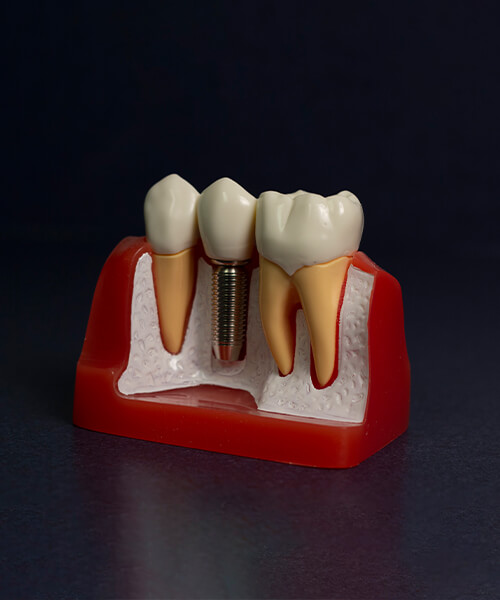Dental Implants
Restorative Dentistry

Dental implants are the gold standard for replacing missing teeth. Dental implants are artificial roots for teeth. They are titanium screws that are placed in the jawbone. After they are placed, bone will grow around them. This bone essentially locks them in place, allowing us to place a tooth on top. Dental implants can be used to replace a single missing tooth, or multiple implants may be placed to replace multiple teeth.
They are a great way to restore your ability to chew and smile. Once restored you care for your implants just like your natural teeth. Keep up your brushing and flossing and see your dental hygienist regularly for cleanings.
Facts about Dental Implants
Dental implants are surgically placed in your jawbone, where they serve as the roots of missing teeth. Because the titanium in the implants fuses with your jawbone, the implants won’t slip, make noise, or cause bone damage the way fixed bridgework or dentures might. The materials also don’t decay.
In general, dental implants may be right for you if you:
- Have one or more missing teeth
- Have a jawbone that’s reached full growth
- Have adequate bone to secure the implants or are able to have a bone graft
- Have healthy oral tissues
- Don’t have health conditions that will affect bone healing
- Are unable or unwilling to wear dentures
- Want to improve your speech
- Are willing to commit several months to the process
- Don’t smoke tobacco
Dental Implant Procedure
The process of placing a dental implant involves multiple visits and steps, including:
- Removing the damaged tooth
- Preparing the jawbone if needed with dental grafting
- Placement of the implant
After the dental implant bonds with your natural bone, an abutment is placed over the implant, and a crown is placed over the abutment.
Dental implants are the strongest options available for tooth replacement, and the tooth looks and feels natural.
When Bone Grafting is Required
If your jawbone is too soft or isn’t thick enough or wide enough, you may need bone grafting after the tooth is removed and before the implant is placed. This step entails placing material around the jawbone in that area. It may then take several months for enough new bone to grow in order to support a dental implant. The grafting may be completed at the same time as the tooth removal or implant procedure. In some cases, all three steps – the tooth removal, bone grafting, and dental implant – can be completed at once.
